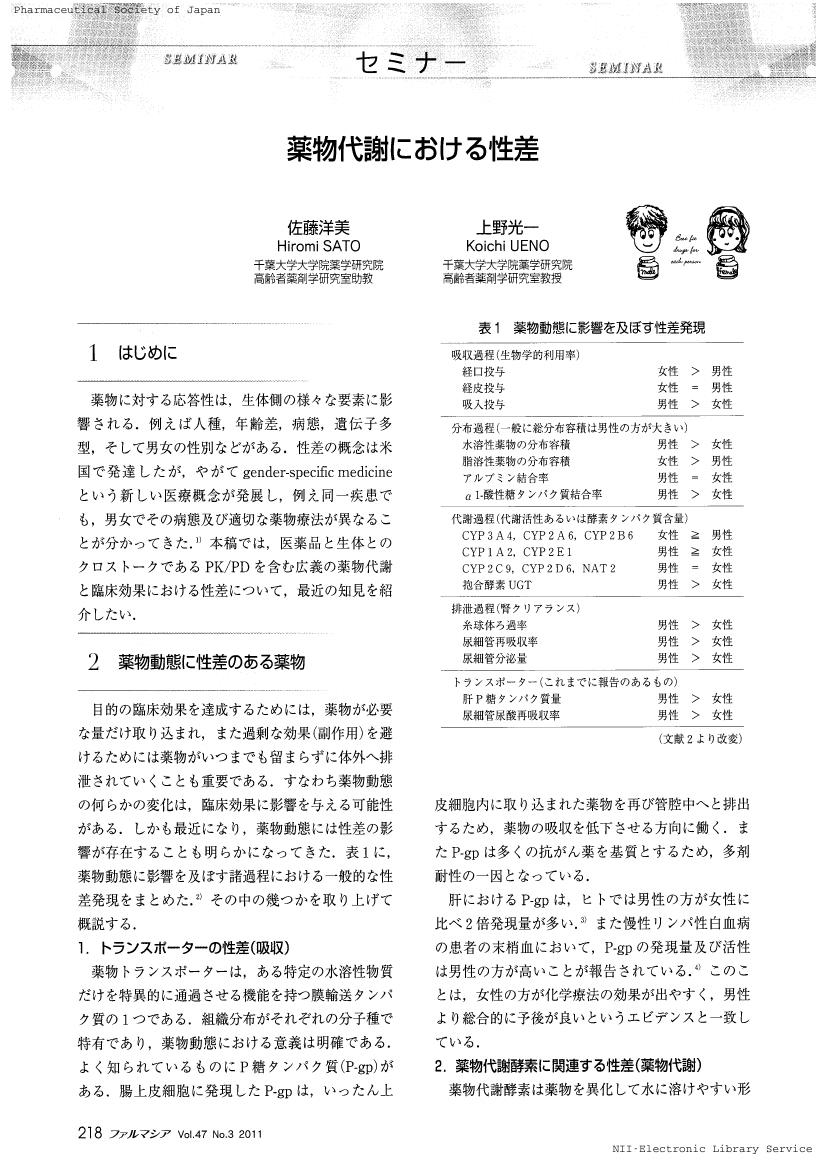5 0 0 0 OA 薬物代謝における性差
- 著者
- 佐藤 洋美 上野 光一
- 出版者
- 公益社団法人 日本薬学会
- 雑誌
- ファルマシア (ISSN:00148601)
- 巻号頁・発行日
- vol.47, no.3, pp.218-222, 2011-03-01 (Released:2017-02-24)
- 被引用文献数
- 1
3 0 0 0 OA ヒスタミン受容体の皮膚及び骨組織における発現と機能
- 著者
- 上野 光一
- 出版者
- 公益社団法人 日本薬学会
- 雑誌
- YAKUGAKU ZASSHI (ISSN:00316903)
- 巻号頁・発行日
- vol.134, no.11, pp.1093-1108, 2014-11-01 (Released:2014-11-01)
- 参考文献数
- 77
Histamine was first identified in 1910 as a physiologically active amine. It is now recognized for its multiple regulatory activities in the digestive, neuronal, and immune systems, and new roles are still being elucidated. Histamine exerts its effects through four distinct receptor subtypes. The histamine H4 receptor was identified in 2000 and is the most recently identified of the four histamine receptors. It is expressed primarily in immune cells and is involved in physiologic functions related to inflammation and allergy. Recently, the H4 receptor was highlighted as a promising therapeutic target in atopic dermatitis, asthma, and chronic arthritis. In fact, some H4 receptor antagonists have reached clinical trials for the treatment of asthma, atopic dermatitis, and allergic rhinitis. Based on an initial assessment of its distribution, the H4 receptor has been referred to as the histamine receptor of the hematopoietic system. However, the H4 receptor has also been implicated in the regulation of other non-hematopoietic systems. Here, I review the expression and function of the identified histamine receptors, including the H4 receptor with a focus on articular and dermal tissues. In articular tissue, H4 receptor expression has been detected in synovial cells. Chondrocytes, a major cell source for cartilage tissue engineering, also express the H4 receptor. In skin, the H4 receptor is expressed in both the epidermis and dermis, with stronger receptor expression in the epidermis. Further understanding of the functions of H4 receptors in non-hematopoietic cells might lead to novel treatments for diseases with unmet medical needs.
2 0 0 0 OA 医療機関から処方されている医薬品の男女別使用実態に関する研究
- 著者
- 根岸 悦子 土門 由佳 上田 まなみ 門脇 京子 上野 光一
- 出版者
- 公益社団法人 日本薬学会
- 雑誌
- YAKUGAKU ZASSHI (ISSN:00316903)
- 巻号頁・発行日
- vol.125, no.10, pp.821-827, 2005-10-01 (Released:2005-10-01)
- 参考文献数
- 15
- 被引用文献数
- 4 3
In recent years, the concept of gender-specific medicine has become generalized in Japan. We need to understand gender differences in the pattern of use prescription drugs for the appropriate use of medications. We therefore investigated gender differences in the use of prescription drugs based on data form nine hospitals in Japan. The data were extracted from their drug ordering systems in the month from March 1 to 31, 2003. We analyzed the data from the viewpoints of sex and age. The frequency of prescriptions for central nervous system drugs and Kampo medicines was higher for women than for men. The same trend was seen for hormones and vitamins. On the other hand, the frequency of prescriptions for cardiovascular drugs for men was higher than that for women. The same trend was found for unclassified metabolic drugs such as arthrifuges. As a result of detailed analysis by age-group, it is suggested that a correlation exists between the age specificity of prescription drugs and gender differences in disease occurrence. This information had not previously been investigated in Japan. Since the results appear useful, we to improve perform more detailed analyses and accumulate evidence to improve drug therapy.
2 0 0 0 OA 4. 臨床薬理学からみた性差医学
- 著者
- 上野 光一
- 出版者
- 一般社団法人 日本臨床薬理学会
- 雑誌
- 臨床薬理 (ISSN:03881601)
- 巻号頁・発行日
- vol.37, no.3, pp.165-169, 2006-05-31 (Released:2010-06-28)
- 参考文献数
- 12
2 0 0 0 OA 安全な医薬品の開発及び適正使用に関する性差医療研究
- 著者
- 佐藤 洋美 島田 万里江 佐藤 友美 シディグ サーナ 関根 祐子 山浦 克典 上野 光一
- 出版者
- 日本毒性学会
- 雑誌
- 日本毒性学会学術年会 第40回日本毒性学会学術年会
- 巻号頁・発行日
- pp.150526, 2013 (Released:2013-08-14)
【目的】医薬品の中には、対象疾病の受療率に男女差があり、男女のどちらかに偏って使用されるものが少なからず存在する。また、薬物動態や薬効・副作用の発現に性差の存在する薬物も多々存在することが報告されている。そこで、安全な医薬品の開発及び個々人に対する医薬品の適正使用に還元されることを目的として、本検討においては、申請資料概要が提出済みの既承認医薬品の中で、女性が組み込まれている臨床試験を実施したものがどの程度存在するかを調査し、解析を行った。【方法】独立行政法人医薬品医療機器総合機構(Pharmaceuticals and Medical Devices Agency: PMDA)のホームページから検索を行った。2001年4月から2011年12月に承認審査された医薬品のうち、申請資料概要が入手可能な医薬品を対象に調査し、臨床試験における各相の女性の組み込み等について解析を行った。【結果】承認審査された医薬品のうち、国内または海外における第Ⅰ相~Ⅲ相試験及び臨床薬理試験のいずれかには女性は非常に高い割合で組み込まれていた。しかし、第Ⅰ相試験や臨床薬理試験に関しては、女性の組み込み率が低かった。女性を組み込んでいても男女別のデータを区別している医薬品はさらに少なかった。一方、女性が組み込まれ、データを区別している医薬品の添付文書において、性差に関する記述が記載されている医薬品は極めて少なかった。【考察】第Ⅰ相試験や臨床薬理試験の女性の組み込み率が低いことより、薬物動態や薬力学的作用における性差の概念が浸透していないことが考えられた。また、男女のデータを区別している医薬品において、性差に臨床的意義がない場合は添付文書にその旨を記載していないことが多いが、臨床効果に性差がなかったことを記載することは医療現場における安全な医薬品適正使用に貢献すると思われる。
2 0 0 0 薬物代謝における性差
- 著者
- 佐藤 洋美 上野 光一
- 出版者
- 公益社団法人 日本薬学会
- 雑誌
- ファルマシア (ISSN:00148601)
- 巻号頁・発行日
- vol.47, no.3, pp.218-222, 2011
- 参考文献数
- 23
1 0 0 0 OA ヒト組織におけるヒスタミンH4受容体発現と臨床的意義
- 著者
- 山浦 克典 鈴木 昌彦 並木 隆雄 上野 光一
- 出版者
- 公益社団法人 日本薬理学会
- 雑誌
- 日本薬理学雑誌 (ISSN:00155691)
- 巻号頁・発行日
- vol.135, no.6, pp.235-239, 2010 (Released:2010-06-11)
- 参考文献数
- 59
- 被引用文献数
- 1 1
2000年に新規同定されたヒスタミンH4受容体は,主に免疫系細胞に発現し免疫反応への関与が示唆されている.我々は関節リウマチ患者の関節滑膜に着目し,マクロファージ様および線維芽細胞様滑膜細胞いずれにもH4受容体が発現していることを確認した.次に,表皮および真皮のH4受容体発現を検討し,表皮においてはケラチノサイトが分化に伴いH4受容体の発現を増強することを,また真皮においては真皮線維芽細胞にH4受容体が発現することを確認した.さらに,皮膚に発現するH4受容体の役割として掻痒反応への関与が示唆されているため,サブスタンスPによるマウス掻痒反応において,H4受容体遮断薬が抗掻痒作用を示すことを確認した.サブスタンスPにより誘発する掻痒反応では,マスト細胞の関与は小さいこと,ケラチノサイトが反応に重要な役割を果たすとされることから,ケラチノサイトに発現するH4受容体を介する掻痒反応機構の存在が示唆された.
1 0 0 0 OA 薬物代謝の性差
- 著者
- 佐藤 洋美 上野 光一
- 出版者
- 日本毒性学会
- 雑誌
- 日本毒性学会学術年会 第45回日本毒性学会学術年会
- 巻号頁・発行日
- pp.S20-2, 2018 (Released:2018-08-10)
薬物治療において薬効や副作用に男女差が現れる場合がある。実際には薬力学的および薬物動態学的な発現機構が組み合わさって臨床的性差として現われる。 薬物の体内動態の観点では、薬物の血中濃度は主に分布容積とクリアランスにより決定されるので、分布容積に差を与える要因、すなわち脂肪含量・循環血液量・筋肉量・肺胞面積等の違いや、腎クリアランスが女性で小さいことなどから、一般に女性で血中薬物濃度が高くなりがちである。 薬物代謝の観点では、ヒトの多くの薬物代謝反応に関与するCYP3A4の性差については女性で活性が高いとする報告が比較的多いが、肝臓と小腸で状況は異なる。一方、近年のヒトCYP3A4導入マウスを用いた検討で、雌性マウスにおいて肝臓CYP3A4発現および活性が雄性ラットよりも高いことが示されている。他のCYP分子種の性差も報告されているが、見解が一致するものは少ない。また、薬物の吸収や排泄に影響を与えるトランスポーターの性差もクリアランスに影響を与える要因であるが、薬物排出トランスポーターであるP-gpの性差も示唆されている。 薬理作用の観点では、片方の性で強めに薬効が発現する例として、塩酸ピオグリタゾン、トリアゾラム、SSRIなどは男性に比べて女性で強く現れる。さらに、薬剤性肝障害やアレルギー性皮膚炎も女性に多い。これらの要因には、性ホルモンや免疫機能あるいはセロトニンなどの受容体の性差が関与することが明らかにされつつある。 性差は加齢によって変動する場合もある。加齢による性ホルモン分泌量や生理機能変化の影響は考慮が必要である。動物種間で性差の出方も異なる。どのような人(動物)を対象に、いつ何で観察された事象であるのかも含めて、情報を整理する必要がある。本発表では、薬物動態や代謝に性差の見られる医薬品について、最近の知見も含めて紹介する。

